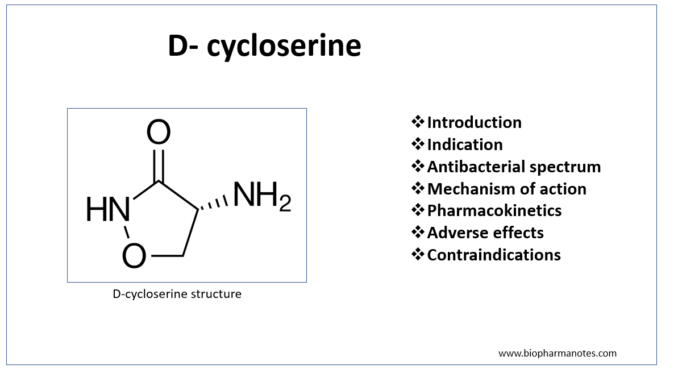
- Cycloserine is broad spectrum antibiotic having tuberculostatic effect. It is obtained from S. orchidaceous and S. garyphalus. It is analogue of amino acid D-alanine. Chemically, it is D-4-amino-3isoxazolidone.
- It is used in tuberculosis therapy since late 1950s. It is included in World Health Organization’s List of Essential Medicines.
Indications of D-cycloserine
- Used to treat tuberculosis. It is mostly used as second line agent in treating drug resistant tuberculosis in combination with other anti-tuberculosis agents.
- Used in certain UTIs (Urinary Tract Infection).
- Used in combination with other agents to treat Mycobacterium avium complex (MAC).
Anti-bacterial spectrum of D-cycloserine
- It is effective against M. tuberculosis. Also, is effective against tubercle bacilli resistant to isoniazid (INH) and streptomycin. It is also effective against atypical mycobacteria.
- It has bactericidal or bacteriostatic effect depending on its concentration at site of infection and susceptibility of organism.
Mechanism of action of d-cycloserine
- As it is analogue of amino acid D-alanine, it causes competitive inhibition of two enzymes- L-alanine racemase which forms D-alanine from L-alanine and D-alanylalanine synthetase. D- alanylalanine synthetase incorporates D- alanine into the pentapeptide which is required for formation of peptidoglycan and synthesis of bacterial cell wall.
- Hence, it interferes with early step of bacterial cell wall synthesis and results in inhibition of bacterial cell wall.
- It also has selective NMDA partial agonist activity which acts at glycine binding site of NMDA receptor.
Pharmacokinetics
- It is administered via oral route and is rapidly absorbed from GI tract. Its absorption may be reduced by high-fat meal. Peak plasma level reaches within 4 hours. It is distributed throughout the body including CSF. It’s concentration in CSF is same in plasma, particularly in case of inflamed meninges.
- Around 50% of drug administered is excreted unchanged in urine within 12 hours. Drug accumulation may occur in patients with renal insufficiency. Very little amount of D-cycloserine is metabolized.
Adverse effects
- Its major effect is psycho- neuro- toxicity which limit its use. Neurological effect is characterized by slurred speech, ataxia, peripheral neuropathy and seizures and psychic effect is characterized by insomnia, anxiety, nervousness, delusions and hallucinations. It can also increase suicidal tendency.
Contraindications
- Contraindicated in patients with history of epilepsy.
- It is contraindicated in patients with severe depression.
References
- https://go.drugbank.com/drugs/DB00260
- https://pubchem.ncbi.nlm.nih.gov/compound/d-cycloserine
- Int J Neuropsychopharmacol. 2016 Apr; 19(4): pyv102.
- Schade et al. D-Cycloserine in Neuropsychiatric Diseases: A Systematic Review. Int J Neuropsychopharmacol. 2016; 19(4): pyv102.
- Mandell, Douglas, and Bennett’s Principles and Practice of Infectious Diseases (Eighth Edition). 2015; 1: 463-478.e3.
- Pharmacology and Pharmacotherapeutics. 24th edition.
- Lippincott Illustrated Reviews Pharmacology, 6th edition.
- Goodman and Gillman’s Manual of Pharmacology.